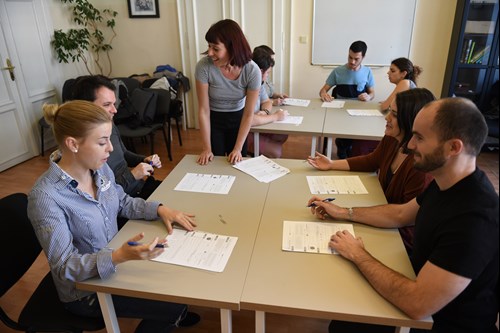Advantages of using videos in ESL/EFL lessons
In the modern world of language teaching, many teachers heavily rely on using real-world videos as a teaching resource. A real-world video is a video which was not made or intended to be used specifically for language lessons—for example, news reports, documentaries, scenes from TV shows, trailers, music videos, instructional videos, interviews, performances, etc. Using a real-world video can lead to student growth and progress, and increase students’ confidence in using their language skills in real life. Let’s dive into some of the advantages of using real-world videos as a tool for teaching a language.
Sponsored advertorial by Fluentize.

Exposure to unfamiliar accents, tones, pronunciation, & terminology
Video gives learners a truly authentic learning experience. It can take the learner away from the teacher’s voice for a period of time and allows the learners to hear multiple speakers using the language in natural contexts. Why does this help with their learning? Well, it's quite common for students to understand their teacher probably better than many other English speakers for two reasons – the first reason being that students are often used to the teacher’s voice. And the second is that teachers often grade their language down a bit when speaking with their students, and tend to speak a bit more clearly, simply, and slowly, in order for students to understand them. Language teachers are often aware that they speak differently to their friends at home compared with their students in their classes.
Therefore, when students watch a video with someone else using the target language, they get a break from the teacher’s voice and must train their ear to different voices, accents, tones, pronunciation, and terminology. Consequently, it becomes an incredibly beneficial experience for learners to train their listening comprehension skills.

Activates two channels for learning
Language learners benefit immensely from watching videos because they must simultaneously activate two sensory channels – listening and viewing. Simply put, when you watch a video, you hear the sound and see the motion picture at the same time. This helps learners ‘fill in the gaps’ – if there are unknown words, terminology, or expressions to students while watching a video, they have the visual element, as well as contextual dialogue or speech, to help them supplement those missing gaps and help them contextualize the new language.
Vocabulary is learned much more effectively when matched with visuals/video rather than definitions/explanations. Language learners tend to remember the imagery, visuals, sounds, objects, faces, and voices in the context of the video, and therefore build a stronger mental association to the vocabulary words that were used in the video.
Topical and cultural value
We’re bombarded with videos all day online and on social media – it has become such a normalized medium for communication, information, entertainment, advertising, and art. There are videos used in a variety of contexts in just about any industry, and no matter what the learners’ interests are, there are most likely videos somewhere on the web that are relevant to and suit their interests.
The types of video mentioned above can also be valuable in terms of cultural education. When learners are exposed to real-world videos, it can help them learn about the culture and get to know the people, customs, beliefs, sports, foods, lifestyles, and values of those who speak the target language. This is useful because the more someone is educated in culture, the more they develop open-mindedness and, in turn, the likelihood of developing intercultural empathy – an important trait in today’s globalized world.


Take for example, a class watching a video about the sport of Irish hurling. Since hurling is quite specific to Ireland only, the students are learning something new about Irish culture. And lastly, back to the point about exposure mentioned earlier—if they’re watching a video about Irish hurling, they’re likely listening to someone talk about hurling with an Irish accent.
Trains understanding and encourages speaking skills
Although watching videos would be considered a passive activity, videos are often full of content that can then be turned active. Basically, they provoke a reaction from students and can inspire students to speak their mind about the topics or themes presented in the video, and they help plant the seed for great classroom discussion. In other words, watching videos helps your students train their listening comprehension, and then in turn also encourages them to share their opinion about the topic, speak about their own experiences, and relate to the topic personally. These are skills that are important to develop for any language learner. Video is also used as a medium for artistic and creative expression it often tells a story which can allow the viewer to make a special emotional connection with the content. Emotion often leads to motivation, inspiration, and creative expression. Contribution from students in response to watching a video is often higher in comparison with reading a text, and it’s a tool for providing a balanced learning experience of both passive and active student engagement.
Linguistic value and the level of student engagement
Perhaps the most significant value of using videos in your lessons is how they can be used to help your students grow and make progress linguistically. Videos are inherently packed with natural linguistic material – there is so much you can extract from a video and turn into an educational activity to help students build their vocabulary, grammar, pronunciation, listening, speaking, and more. It can be very effective to take a short, engaging video and then transform its contents into a lesson plan with different kinds of activities, designed to help learners improve their core skills.
Even though the aim of the lesson should be linguistic development, videos can also provide value in terms of student engagement as well. When students are interested or engaged in the lesson topics, they tend to be more motivated to learn. Many teachers agree that playing videos for students creates a lively classroom atmosphere. You might even spontaneously come up with some new questions or activities for your students while the video is playing, which you can then use to generate additional discussion with them after viewing. All in all, using video is a great tool to step up student engagement.
Remember that real-world videos can be a great tool to help your students develop their language skills. Both students and teachers typically enjoy working with videos and I encourage all language teachers to incorporate them somehow into lessons. Connecting with students and their own opinions, experiences, and stories related to the lesson topics can help teachers build great relationships with their students!
Click here to learn more about Fluentize – an online resource dedicated to English language teachers providing modern and comprehensive ESL lesson plans based on real-world videos.
The content for this page was paid for and provided by Fluentize.

Comments
Write a Comment
Comment Submitted